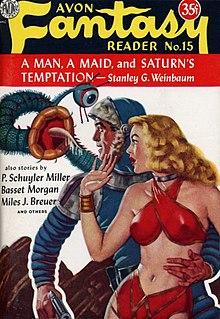Flight on Titan
The Vicks escape the destruction of their shack, but find themselves stranded a hundred miles from the main human settlement on Titan, the United States-ran Nivia, otherwise known as the City of Snow, on the far side of the Mountains of the Damned.
He resumes climbing, dragging the unconscious Diane with him, until he passes the summit and starts down the far side, with the lights of Nivia visible in the foothills below.
In Weinbaum's description of the Solar System, in accordance with the then-accepted near-collision hypothesis of planetary formation, the gas giants radiate enough heat to bring their inner satellites up to Earth-like temperatures.
Titan's temperature is comparable to Earth's Antarctic regions, ranging from just above freezing during the day to eighty below zero Fahrenheit during the nine-hour-long nights.
Despite all this, Titan has a flourishing Arctic ecosystem, apparently at the top of which is a clawed, blubbery seal-like native race of infant-like intelligence.
"The natives", as they are simply known, have developed a barter system with settlers from Earth, trading rare, precious and expensive Titanian gems for knives, beads, mirrors, and other trinkets.
Less sentient Titanian life-forms include the elastic, stinging "Whiplash Trees"; small, three-legged "Ice-Ants" which create oval ice-hives; giant, one-eyed, hypnosis-inducing, cave-dwelling "Threadworm"; and an airborne predator the size of a pterodactyl called a "Knife-Kite."
All life on Titan has a metabolism based on arsenic, and so have to be chemically treated to render them safe before being eaten by humans.

